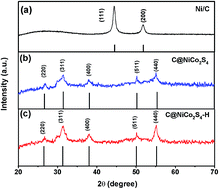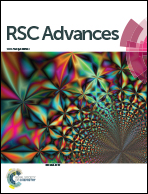Carbon@NiCo2S4 nanorods: an excellent electrode material for supercapacitors†
Abstract
Carbon@NiCo2S4 nanorods were synthesized through a facile in situ hydrothermal approach using carbon supported nickel (Ni/C) nanorods as both the template and nickel source. The morphology and electrochemical properties of NiCo2S4 can be effectively tuned with carbon nanorods as well as the addition of hydrogen peroxide (H2O2) during the hydrothermal process. The carbon nanorod endows NiCo2S4 with rod-like morphology and good electrochemical stability during active reversible redox reactions. Moreover, the addition of H2O2 creates the porous structure of NiCo2S4, improving its electrochemically active surface area greatly, which is beneficial for efficient charge and ion transport in electrodes. Electrochemical measurements indicate that the H2O2 treated carbon@NiCo2S4 (labeled as C@NiCo2S4–H) nanorods present high specific capacitance (1455 F g−1 at the current density of 1 A g−1) and excellent cycling stability (83% retention after 2000 cycles). It is believed that other carbon-based composites with superior electrochemical behavior for supercapacitor applications can also be synthesized using the proposed method in this study.


 Please wait while we load your content...
Please wait while we load your content...